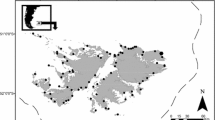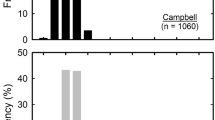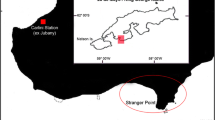Abstract
The diet of black-browed albatrosses was studied at Gonzalo Island, Diego Ramirez, Chile, during the early chick-rearing periods of 2000, 2001, and 2002. Diet composition was determined by sampling chick-stomach contents during January and February of each year. Reconstituted meal mass was similar throughout the study, with diet being dominated by fish in all 3 years. Overall, the main items taken were the fishes Macruronus magellanicus (66–89% by mass) and Micromesistius australis (2.6–3.7% by mass), which are both fisheries-related species, and the squid Martialia hyadesi (8–20% by mass). The distribution of the prey species indicates that black-browed albatrosses obtained the bulk of their food over the South American continental shelf, but also foraged at the Antarctic Polar Front. The prevalence in the diet of fish species discarded from fishing operations, and the presence of fish hooks and fish bait species, indicate a strong association with fisheries in southern Chile.






Similar content being viewed by others
References
AFMA (2001) AFMA Bycatch Action Plans—Subantarctic Fishery. http://www.afma.gov.au. Cited 31 March 2001
Barnard JL (1991) The families and genera of marine Gammaridean Amphipoda (except marine gammaroids), Part 1. Rec Aust Mus [Suppl 13]
CCAMLR (2002) Conservation Measure 25-02 (2002). Schedule of conservation measures in force 2002/03 season. http://www.ccamlr.org.
Cherel Y, Klages N (1998) A review of the food of albatrosses. In: Robertson G, Gales R (eds) Albatross biology and conservation. Surrey Beatty, Chipping Norton, pp 113–136
Cherel Y, Weimerskirch H, Trouvé C (2000) Food and feeding ecology of the neritic-slope forager black-browed albatross and its relationships with commercial fisheries in Kerguelen waters. Mar Ecol Prog Ser 207:183–199
Cherel Y, Weimerskirch H, Trouvé C (2002) Dietary evidence for spatial foraging segregation in sympatric albatrosses (Diomedea spp.) rearing chicks at Iles Nuageuses, Kerguelen. Mar Biol 141:1117–1129
Clarke MR (1986) A handbook for the identification of cephalopod beaks. Claredon, Oxford
Cohen DM, Inada T, Iwamoto T, Scialabba N (1990) Gadiform fishes of the world (Order Gadiformes). An annotated and illustrated catalogue of cods, hakes, grenadiers and other gadiform fishes known to date. FAO species catalog, vol 10. FAO Fish Synop 125, Rome
Cooper J (1995) Fishing hooks associated with albatrosses at Bird Island, South Georgia, 1992/1993. Mar Ornithol 23:17–21
Croxall JP, Prince PA (1994) Dead or alive, night or day: how do albatrosses catch squid? Antarct Sci 6:155–162
Duffy DC, Jackson S (1986) Diet studies of seabirds: a review of methods. Colon Waterbird 9:1–17
Furness BL, Laugksch RC, Duffy DC (1984) Cephalopod beaks and studies of seabird diets. Auk 101:619–620
Hatfield EMC, Rodhouse PG (1996) Biology and fishery of the Patagonian squid Loligo gahi (D'Orbigny, 1835): a review of current knowledge. J Cephalopod Biol 2:41–49
Hecht T (1987) A guide to the otoliths of southern ocean fishes. S Afr J Antarct Res 17:2–87
Kirkwood JM (1982) A guide to the Euphausiacea of the southern ocean. ANARE Res Notes 1
Kirkwood JM (1983) A guide to the Decapoda of the southern ocean. ANARE Res Notes 11
Murano M (1999) Mysidacea. In: Boltovskoy D (ed) South Atlantic zooplankton. Backhuys, Leiden, pp 1099–1140
Prince PA (1980) The food and feeding ecology of grey-headed albatross Diomedea chrysostoma and black-browed albatross D. melanophris. Ibis 122:476–488
Prince PA, Croxall JP, Trathan PN, Wood AG (1998) The pelagic distribution of South Georgia albatrosses and their relationships with fisheries. In: Robertson G, Gales R (eds) Albatross biology and conservation. Surrey Beatty, Chipping Norton, pp 137–167
Reid K (1996) A guide to the use of otoliths in the study of predators at South Georgia. British Antarctic Survey, Cambridge
Reid K, Arnould JPY (1996) The diet of Antarctic fur seals Arctocephalus gazella during the breeding season at South Georgia. Polar Biol 16:105–114
Reid K, Croxall JP, Prince PA (1996) The fish diet of black-browed albatross Diomedea melanophris and grey-headed albatross D. chrysostoma at South Georgia. Polar Biol 16:469–477
Retamal MA (1981) Catalogo ilustrado de los crustáceos decápodos de Chile. Gayana Zool 44:7–110
Ridoux V (1994) The diets and dietary segregation of seabirds at the subantarctic Crozet Islands. Mar Ornithol 22:1–192
Rodhouse PG (1998) Large and meso-scale distribution of the ommastrephid squid Martialia hyadesi in the southern ocean: a synthesis of information relevant to fishery forecasting and management. Korean J Polar Res 8:145–154
Rodhouse PG, Prince PA (1993) Cephalopod prey of the black-browed albatross Diomedea melanophrys at South Georgia. Polar Biol 13:373–376
Rodhouse PG, Prince PA, Clarke MR, Murray AWA (1990) Cephalopod prey of the grey headed albatross Diomedea chrysostoma. Mar Biol 104:353–362
Rodhouse PG, Arnbom T, Fedak MA, Yeatman J, Murray AWA (1992) Cephalopod prey of the southern elephant seal, Mirounga leonina L. Can J Zool 70:1007–1015
Schlatter RP, Riveros G (1997) Historia natural del Archipiélago Diego Ramírez, Chile. Ser Cient INACH 47:87–112
Smale MJ, Watson G, Hecht T (1995) Otolith atlas of the southern African marine fishes. Ichthyological Monograph no. 1, xiv. JLB Smith Institute of Ichthyology, Grahamstown
Thompson KR (1992) Quantitative analysis of the use of discards from squid trawlers by black-browed albatrosses Diomedea melanophris in the vicinity of the Falkland Islands. Ibis 134:11–21
Thompson KR, Riddy MD (1995) Utilization of offal and discards from "finfish" trawlers around the Falkland Islands by the black-browed albatross Diomedea melanophris. Ibis 137:198–206
Tickell WLN (2000) Albatrosses. Pica, Sussex
Vinogradov G (1999) Amphipoda. In: Boltovskoy D (ed) South Atlantic zooplankton. Backhuys, Leiden, pp 1141–1240
Waugh SM, Weimerskirch H, Cherel Y, Shankar U, Prince PA, Sagar PM (1999) Exploitation of the marine environment by two sympatric albatrosses in the Pacific southern ocean. Mar Ecol Prog Ser 177:243–254
Williams R, McEldowney A (1990) A guide to the fish otoliths from waters off the Australian Antarctic Territory, Heard and Macquarie Islands. ANARE Res Notes 75
Xavier JC, Rodhouse PG, Trathan PN, Wood AG (1999) A Geographical Information System (GIS) atlas of cephalopod distribution in the southern ocean. Antarct Sci 11:61–62
Xavier JC, Croxall JP, Reid K (2003) Inter-annual variation in the diets of two albatross species breeding at South Georgia: implications for breeding performance. Ibis (in press)
Acknowledgements
Thanks are due to Graham Robertson for his contributions to paper corrections and discussion, I am also grateful to Carlos Moreno and José Valencia for their suggestions and support in the preliminary stages of the study. I also thank J. Valencia, A. Sepulveda, and M. Muñoz, for their assistance in the field, and to Vilma Ojeda (IFOP), for providing otolith samples from southern Chile and Carlos Jara, Layla Osman, Paul Rodhouse, and Dick Williams for their help in species identification. This research was made possible thanks to a collaboration program between the Instituto Antartico Chileno (INACH), the Universidad Austral de Chile (UACH), the Australian Antarctic Division (AAD), and the British Antarctic Survey (BAS). Further financial assistance for laboratory expenses was provided through a project of the Direccion de Investigacion y Desarrollo (DID), UACH. Financial support for my stay at Gonzalo Island was provided by a scholarship from the Comision Nacional de Investigacion Cientifica y Tecnologica (CONICYT), Chile.
Author information
Authors and Affiliations
Corresponding author
Appendix 1
Appendix 1
Table 5 shows the mean mass of individual crustaceans used to reconstitute crustacean prey mass in the diet of black-browed albatrosses at Gonzalo Island, Diego Ramirez.
Rights and permissions
About this article
Cite this article
Arata, J., Xavier, J.C. The diet of black-browed albatrosses at the Diego Ramirez Islands, Chile. Polar Biol 26, 638–647 (2003). https://doi.org/10.1007/s00300-003-0530-z
Received:
Accepted:
Published:
Issue Date:
DOI: https://doi.org/10.1007/s00300-003-0530-z




